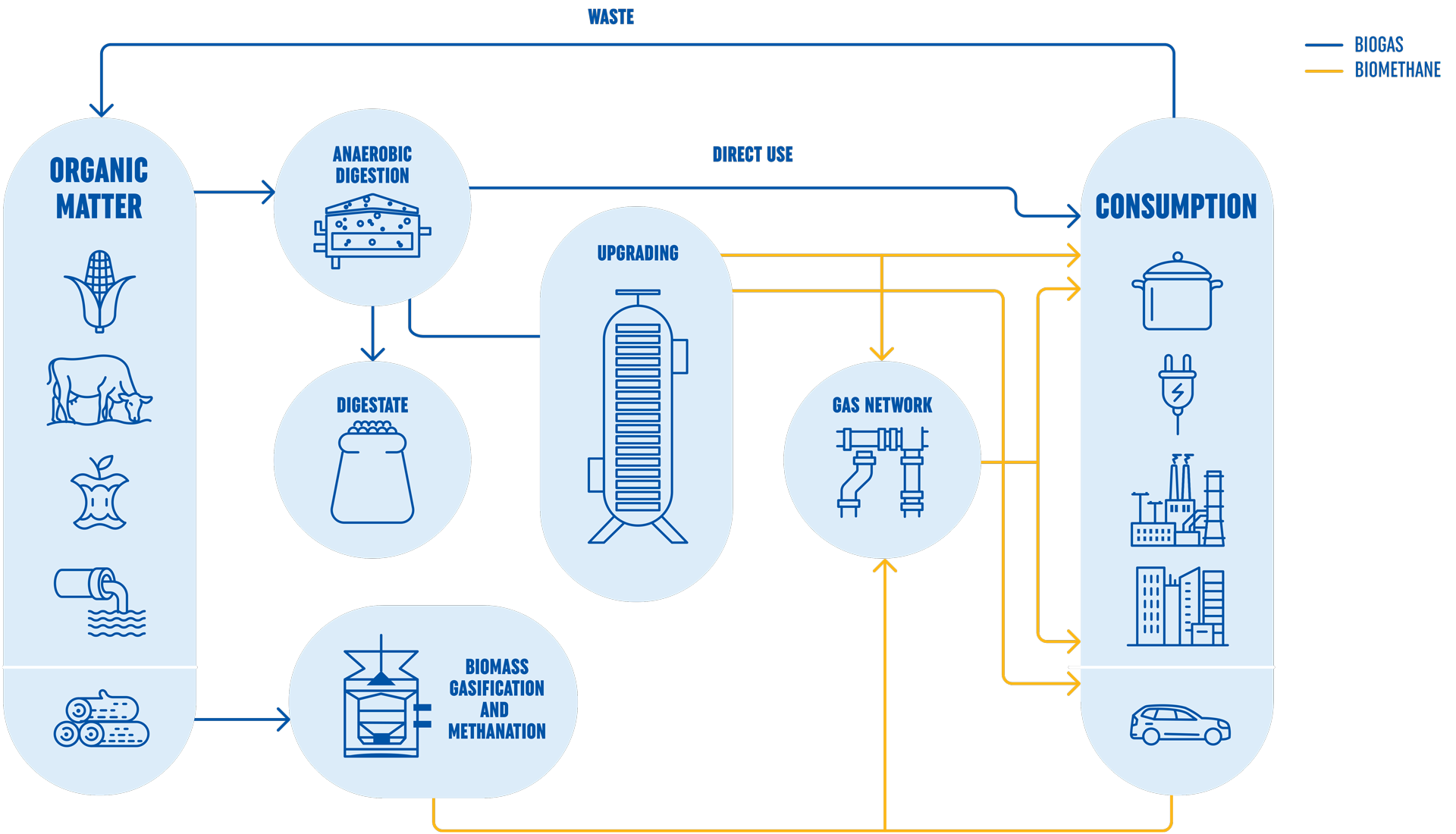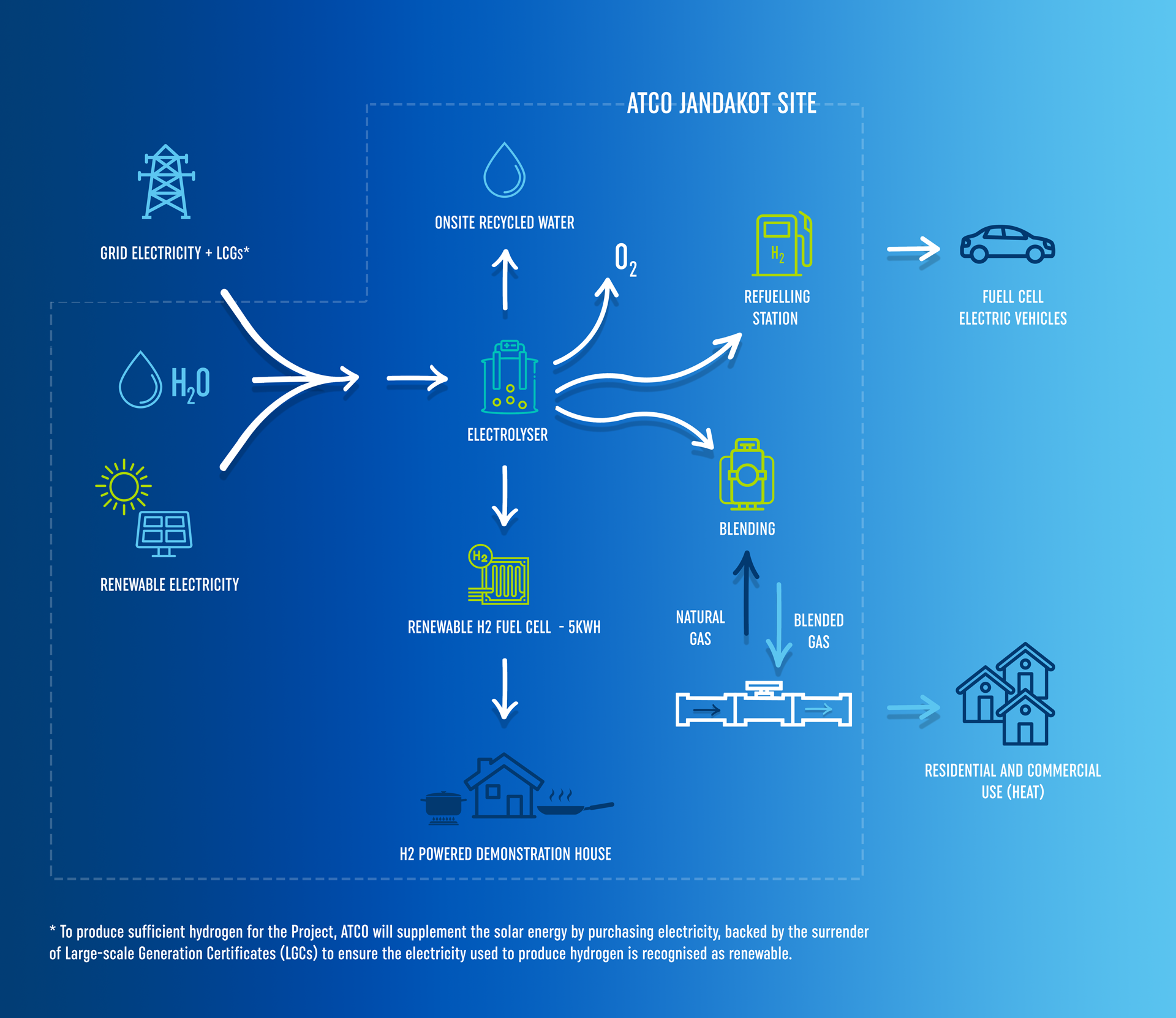Renewable Gas
Renewable Gas is a term used to describe gases that can be used as an energy source which does not produce any additional emissions when you burn them. This makes renewable gas a more sustainable option for the environment compared to natural gas and one viable energy pathway for Australia to reduce its emissions as we head towards a low carbon, sustainable future.
Renewable hydrogen and biomethane are the most common forms of renewable gas. Biomethane is made from biogas, which can be sourced from various forms of material such as green waste, food, industry by-products, agricultural residues, and industrial waste. Biomethane is a renewable gas that can replace natural gas without any modifications to existing gas networks or appliances.
Biogas is produced through a process known as anaerobic digestion, where microorganisms break down raw materials such as agricultural waste, sewage, landfill, and plant material in an oxygen-free environment. The biogas released in the process is predominantly methane (60%), with the remaining 40% consisting of carbon dioxide and trace elements such as hydrogen sulphide, nitrogen, and oxygen. By removing the CO2 and other elements, the biogas can be upgraded to biomethane, resulting in an almost pure methane product.
In the current energy market, biogas is primarily used to generate electricity or is burnt off. However, we have an exciting opportunity to upgrade biogas to biomethane and supply it to households and businesses.
The West Australian gas network and existing gas appliances are well-equipped to handle biomethane. Meaning no significant upgrades or modifications are required to the existing gas infrastructure or household appliances like stoves, heaters, and hot water systems. The seamless integration of biomethane into the existing gas network and appliances offers a straightforward path toward reducing emissions.
Supporting circular economy
Biomethane is produced from organic waste materials such as agricultural waste, food waste, and wastewater. By using these waste materials to produce energy, a circular economy can be created, where waste is transformed into a valuable resource.
Creating local jobs
The production of Renewable Gas can create local jobs in the agriculture, waste management, and energy sectors, supporting local economies.
The Process

Another example of a renewable gas is Renewable Hydrogen
Hydrogen is the most common element in the universe and can be produced using various methods, the most environmentally friendly way being electrolysis, using renewable electricity. This process involves passing an electrical current through water and separating it into hydrogen and oxygen.
When burnt, hydrogen primarily releases heat and water vapour, which is non-toxic. Hydrogen could be blended with natural gas or biomethane and delivered to homes and businesses through existing gas networks or stored for later use.
In the home, like natural gas, hydrogen can be used for heating, hot water, and cooking. It has many more uses in industry such as in steel making, ammonia production, rocket fuel, semiconductor manufacturing, welding, and methanol production.
With the help of State and Federal governments, as well as industry, Australia is shaping up to be a big global player in the renewable hydrogen market. ATCO is currently trialling hydrogen blending into the existing gas network with volumes of up to ten per cent, and is advising industry and government on large-scale renewable hydrogen production.

There are several large renewable gas projects that have been or are being developed in Australia
Australian Gas Infrastructure Group: Hydrogen Park South Australia
Location: Tonsley Innovation District, Adelaide, South Australia
Hydrogen Park South Australia (HyP SA) was Australia’s first project to blend renewable hydrogen with natural gas into an existing network in May 2021, supplying around 700 customers with an up to 5% (by volume) renewable gas blend. HyP SA’s output has been expanded to supply industry and transport, and to increase the volume blend from 5% to 10% to a further 3,000 homes, businesses and schools in Adelaide’s south in the suburbs of Mitchell Park, Clovelly Park and parts of Marion.
Jemena: Western Sydney Hydrogen Hub
Location: Horsley Park, Western Sydney, New South Wales
The Western Sydney Hydrogen Hub (WSHH) generates renewable hydrogen using electrolysis, powered by certified renewable electricity. The hydrogen is then injected and stored in Jemena’s natural gas network. The hydrogen facility bridges current gas solutions with renewable gas generation – which can help map the longer-term future of the Australian gas industry through the energy transition.
ATCO: Hydrogen Community Blending
Location: Jandakot, Western Australia
One of the largest hydrogen projects in Australia, ATCO blends green hydrogen into the natural gas distribution network in the suburbs of Glen Iris, Treeby Estate and Calleya Estate within the City of Cockburn.
In late 2022 around 2,700 customers started to receive a 2-5% renewable hydrogen gas blend and take steps towards a higher blending of up to 10% by volume network-wide by 2030.
Australian Gas Infrastructure Group: Hydrogen Park Murray Valley
Location: Wodonga, Victoria
The Hydrogen Park Murray Valley (HyP MV) project will be one of the largest renewable hydrogen production and blending projects in Australia.
The renewable hydrogen will be blended with natural gas, at volumes of up to 10% for supply into the existing gas distribution networks across Albury and Wodonga, helping to reduce carbon emissions from the energy supply more than 40,000 business and residential connections.
In the future, HyP Murray Valley will also have the capacity to supply industry and transport markets.
Jemena: Malabar Biomethane Injection Project
Location: Malabar, New South Wales
The Malabar Biomethane Injection Plant (MBIP) demonstrates the potential for a biomethane sector to provide a ‘here-and-now’ pathway to help reduce Australia’s overall carbon emissions and create circular economy benefits.
Biomethane can be blended seamlessly into the existing Jemena gas network.
The project has an initial capacity of 95 terajoules of renewable gas per annum. This is about equivalent to the average annual gas usage of 6,300 NSW homes.
Australian Gas Infrastructure Group: Hydrogen Park Gladstone
Location: Gladstone, Queensland
HyP Gladstone will be Australia’s first renewable hydrogen production facility to deliver an up to 10% renewable gas blend to an entire city’s existing gas network, reaching around 770 homes and businesses.
This project aims to reduce the carbon emissions from local gas supply. It is now in construction and is expected to be blending to the Gladstone gas distribution network in 2024.
Australian Gas Infrastructure Group: Dampier to Bunbury Gas Pipeline Feasibility Study
Location: Western Australia
This project was developed to identify an efficient and effective pathway to enable hydrogen to be blended into the Dampier to Bunbury Natural Gas Pipeline (DBNGP).
This study builds upon AGIGs investigations into the introduction of hydrogen into low pressure gas distribution networks by focusing on the large-scale DBP asset.
Australian Gas Infrastructure Group: HyHome
Location: Wollert, Victoria
Hydrogen Home (HyHome) is an Australian-first initiative showcasing 100% hydrogen gas appliances in a residential setting – demonstrating the way of the future for gas in the home.
This typical Australian home replaces standard gas appliances with versions that work on 100% hydrogen in a domestic setting. The type of hydrogen we’re using in HyHome for demonstration purposes is created from natural gas, however the type we aim to use in the future is created from renewable electricity.
The home boasts 100% hydrogen powered hot water, ducted heating, and cooking via a cooktop and BBQ. It’s also available for guided tours.
Various: The Australian Hydrogen Centre
The Australian Hydrogen Centre (AHC) brings together industry and government in delivering detailed feasibility studies of blending 10% renewable hydrogen into towns and cities, and ultimately a 100% renewable gas future.
Along with sharing the learnings from Hydrogen Park South Australia (HyP SA), Feasibility studies include:
- 10% hydrogen blending into selected regional towns in VIC and SA
- 10% hydrogen blending into gas networks of VIC and SA
- 100% hydrogen networks for VIC and SA
APA: Parmelia Gas Pipeline Hydrogen Feasibility Study
Location: Kwinana, Western Australia
APA Group completed a study on the feasibility of converting the southern section of the Parmelia natural gas pipeline in Western Australia to pure hydrogen service.
The study successfully demonstrated it is technically feasible, safe and efficient to operate the section of pipeline at current operating pressure using 100 per cent hydrogen.